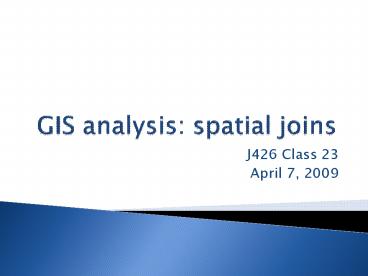GIS analysis: spatial joins PowerPoint PPT Presentation
1 / 21
Title: GIS analysis: spatial joins
1
GIS analysis spatial joins
- J426 Class 23
- April 7, 2009
2
Overview
- Issues in spatial joins
- Point-in-polygon analysis
- Spatial join relationships
3
Spatial joins
- Joins the data in one attribute table for one
feature layer to the attribute table of another
feature layer, like any join - Spatial join joins records in the source table to
one record in the destination table based upon
the spatial relationship of the features
4
Spatial join relationships
- Can use all of the various spatial relationships
used in selecting features, for example - Is contained by
- Is nearest
- Intersect
- Is within distance of
- For each combination of layer type, ArcGIS
provides the spatial relationships that make sense
5
Issue in spatial join relationships
- Some relationships will give unambiguous joins,
such as - Join of non-overlapping polygon features to
points - Any point can be within only one polygon
- That point gets the records from the containing
polygon - Join of points to nearest points
6
Issues in spatial join relationships
- Other spatial join relationships can result in
ambiguous joins, such as - Layer of overlapping polygons to points
- ArcGIS joins first record and provides count of
features satisfying the spatial join relationship
7
Joining polygon layers to point layers
- Often referred to as point-in-polygon analysis
- The records of the polygon layer are joined to
the records of the point layer for the points
inside each polygon - Example joining block group median family income
to crime point locations
8
Example of data in block group polygon theme
9
Example of data in crime point theme
10
Block group and point features
11
Block group family income data joined to crime
points
12
Spatial join relationships
- The following slides indicate the types of
spatial relationships provided by ArcGIS for the
various combinations of layer types
13
Joining point layers to point layers
- Joins points to nearest points
- Choice of attribute information for first nearest
point and distance to nearest point, or - Summary statistics for nearest points and count
of nearest points
14
Joining line layers to point layers
- Joins lines to nearest points
- Choice of attribute information for first nearest
line and distance to nearest line, or - Summary statistics for nearest lines and count of
nearest lines
15
Joining polygon layers to point layers
- Joins polygons to points inside the polygon, or
- Joins polygons to nearest point (with being
inside equivalent to distance of zero) - Provides count of the number of polygons joined
to each point
16
Joining point layers to line layers
- Joins points to nearest lines
- Choice of attribute information for first nearest
point and distance to nearest point, or - Summary statistics for nearest points and count
of nearest points
17
Joining Line Layers to Line Layers
- Joins lines to nearest lines
- Choice of attribute information for first nearest
line and distance to nearest line, or - Summary statistics for nearest lines and count of
nearest lines
18
Joining polygon layers to line layers
- Joins polygons to lines completely inside, or
- Joins polygons to nearest lines, or
- Joins polygons to lines intersects and summary
statistics for intersected polygons and count of
intersected polygons
19
Joining point layers to polygon layers
- Joins points to nearest polygons with distance to
nearest polygon (inside is distance of zero), or - Joins points to containing polygons, with summary
statistics for points and count of number of
points
20
Joining Line Layers to Polygon Layers
- Joins lines to nearest polygons with distance to
polygon (intersection is distance of zero), or - Joins lines intersecting polygons, with summary
statistics for lines and count of number of lines
21
Joining polygon layers to polygon layers
- Joins polygons to polygons in which joining
polygon is completely inside, or - Joins polygons intersecting polygons, with
summary statistics for polygons and count of
number of polygons

